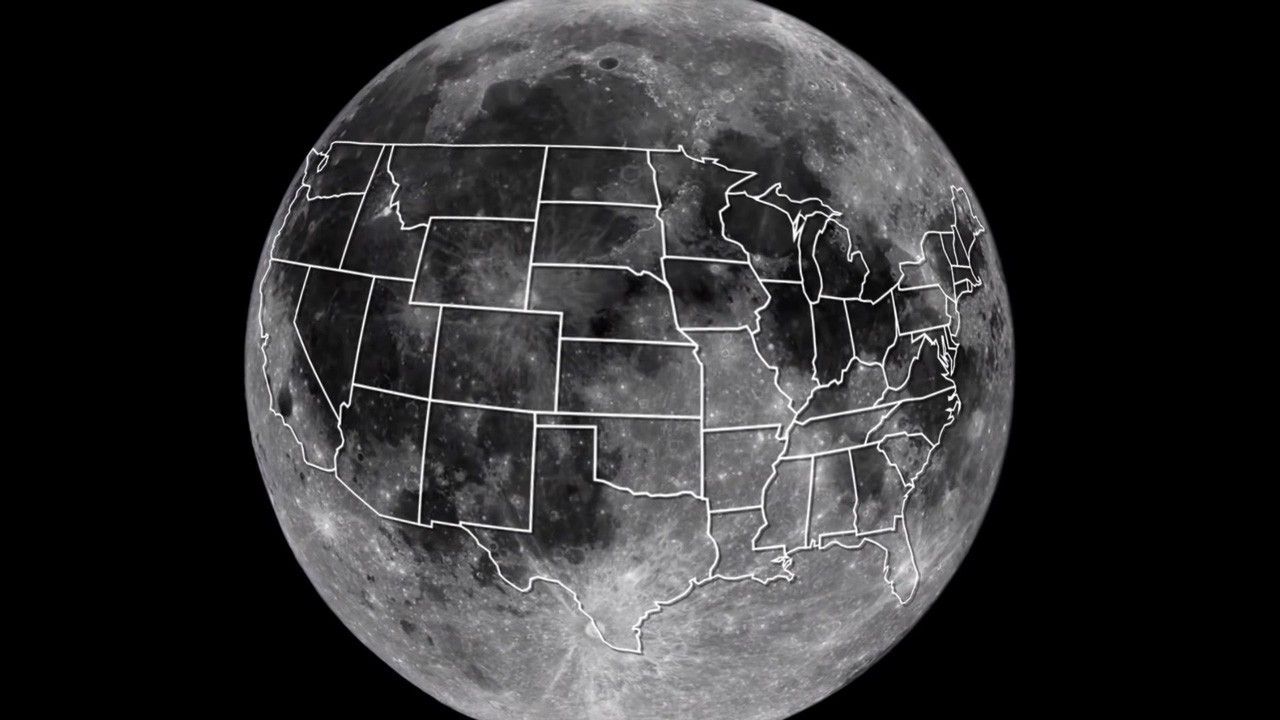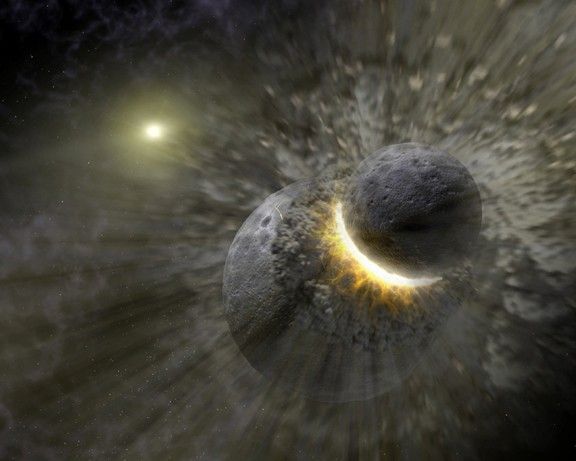At a distance of only 238,900 miles, the Moon orbits fairly close to Earth. As a result, we can learn a lot about our only natural satellite just by observing it from our back gardens. However, there’s more to the Moon than meets the eye. Here are my favorite facts about our celestial neighbor.
6
The Moon Is Pretty Big!
Even though the Moon is by no means the largest planetary satellite in the Solar System, it is the largest relative to its planet—by quite some distance. Here’s a list of each planet’s biggest satellite and their size relative to their planet (neither Mercury nor Venus have moons):
|
Natural Satellite |
Satellite Diameter (km) |
Host Planet |
Planet Diameter (km) |
Ratio |
|---|---|---|---|---|
|
The Moon |
3,474 |
Earth |
12,800 |
0.271 |
|
Triton |
2,710 |
Neptune |
49,528 |
0.055 |
|
Titan |
5,150 |
Saturn |
120,500 |
0.043 |
|
Ganymede |
5,268 |
Jupiter |
139,820 |
0.038 |
|
Titania |
1,578 |
Uranus |
50,724 |
0.031 |
|
Phobos |
23 |
Mars |
6,779 |
0.003 |
Because the Moon is over a quarter the diameter of Earth, the Earth-Moon system is often cited as the pairing in our Solar System that is the closest to being a double planet. However, technically, because the system’s center of mass lies within Earth’s body and not between the Moon and Earth, it doesn’t quite qualify.
To put the Moon’s size relative to Earth into perspective, it’s about as wide as the United States or Europe.
5
We Only Ever See One Side
Don’t let Pink Floyd’s confusingly titled The Dark Side of the Moon fool you into thinking that one side of the Moon is permanently dark. In fact, which half of the Moon is illuminated from Earth’s perspective depends on where our satellite is in its orbit around us.
However, one thing that is true is that we only ever see one side of the Moon, thanks to a phenomenon known as synchronous tidal locking. This process started at birth when a massive object collided with Earth to cause a splattering of debris that coalesced over time. As this coalesced material—the early Moon—spun and changed shape, it released energy in the form of heat. As this energy dissipated, the Moon’s rotation slowed until one rotation on its axis took the same length of time as one orbit around Earth.
In fact, this synchronous tidal locking process isn’t unique to our Moon. Indeed, all the satellites in the table above—each planet’s largest—are tidally locked to their host for the same reason our Moon is locked to us.
4
The Moon Is Moving Away From Us
The Moon’s migration away from Earth is mostly caused by the Earth’s tides. Even though the greatest force between the two bodies involves Earth’s gravity keeping the Moon in orbit, the Moon, in turn, also exerts a gravitational pull on us, causing what’s known as a tidal bulge in our oceans.
Earth’s tidal bulges don’t align exactly with the Moon’s position—in fact, our tidal bulge sits slightly ahead of the Moon, causing a tidal lag. As a result of this lag, Earth’s tidal bulge feeds energy to the Moon, pushing it into a higher orbit.
But don’t worry: it’s only moving away at a rate of less than 4cm a year, which is about the same growth rate as your fingernails! What’s more, even though the Moon leaving our orbit could have catastrophic impacts on Earth, the Sun will likely destroy both our planet and our satellite before that happens.
3
The Moon Is Slowing Down Earth’s Rotation
The story of the tides doesn’t end with the Moon’s migration away from our planet. Previously, I talked about how our tidal bulge sits ahead of the Moon. This tidal lag, which results in the Moon trying to pull the Earth’s tidal bulge back in alignment, slowly saps our planet’s rotational energy, causing its spin to slow.
Once again, this is not something you have to worry about! Indeed, the slowing of the Earth’s spin is only lengthening our day by 2.2 seconds every 100,000 years. In fact, unless we experience a catastrophic event like a massive impact from another celestial body or our Sun becoming a white dwarf, inertia will ensure that our planet will never cease to spin.
2
The Moon’s Formation Was a Dramatic Event
One of the most widely accepted theories of how the Moon was formed about 4.5 billion years ago is that a large celestial object—not too dissimilar to Mars in diameter—collided with a young Earth in a dramatic and violent event.
This collision produced large quantities of extraordinarily hot molten silicate material made up of broken fragments of Earth’s crust and mantle and the perpetrating object. These fragments then cooled and moved into orbit around the Earth in a dense, doughnut-shaped ring before our planet’s gravity grouped them together through further violent collisions to form the Moon.
Previous theories about how the Moon was formed—including that Earth captured it as it passed or that the Moon and Earth were formed at the same time from the same materials—have been debunked through analysis of the rock samples extracted during the Apollo missions during the 1960s and 1970s.
1
Only 12 People Have Walked on the Moon (So Far)
It’s been 53 years since a human set foot on the Moon, with money and politics being the main barriers to modern-day lunar extravehicular activity (EVA).
Amazingly, all twelve people who have walked on the Moon have been males from the United States as part of the Apollo 11 to 17 missions, representing NASA, the United States Air Force, and the United States Navy.
The lengths of the lunar EVAs have increased over time. Neil Armstrong spent less than a full day on the Moon in 1969, and Gene Cernan and Harrison Schmitt had the privilege of spending four days on our natural satellite in 1972.
The good news is that NASA is hoping to end our half-century absence from our celestial neighbor within the next few years. The Artemis mission, which involves five key stages, hopes to put humans on the Moon in 2027:
|
Phase |
Details |
Key Dates |
|---|---|---|
|
Artemis 1 |
This phase was an uncrewed test of the Space Launch System and Orion Module. |
Phase completed (Nov-Dec 2022) |
|
Artemis 2 |
The second phase will be a crewed flight beyond the Moon that will take humans the furthest away from Earth that we’ve ever been. |
No earlier than April 2026 |
|
Artemis 3 |
This will be the first crewed Moon landing since Apollo 17 in 1972. It will place a female and black astronaut on the lunar surface for the first time. |
Mid-2027 |
|
Artemis 4 |
Two more astronauts will land on the Moon during this phase, and a core part of the new lunar space station (Gateway) will be delivered into lunar orbit. |
September 2028 |
|
Artemis 5 |
Phase 5 will involve a third crewed landing, and another core module will be added to Gateway. |
March 2030 |
As with all space missions, the planned Artemis phase dates are subject—and expected—to change. Indeed, all the dates have already changed several times. The dates shown above were correct at the time of writing (February 2025).
You can keep up-to-date with NASA’s Artemis mission via the company’s Artemis blog.





